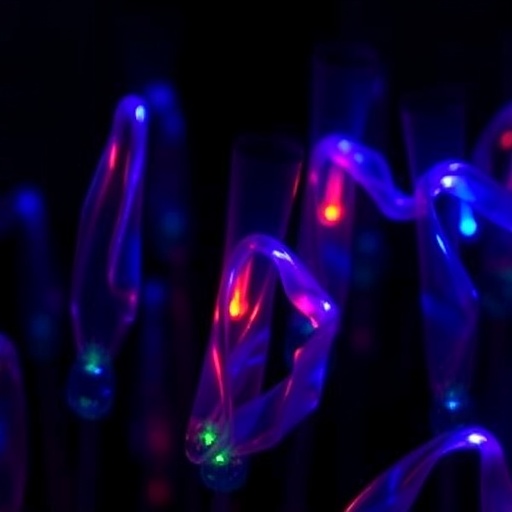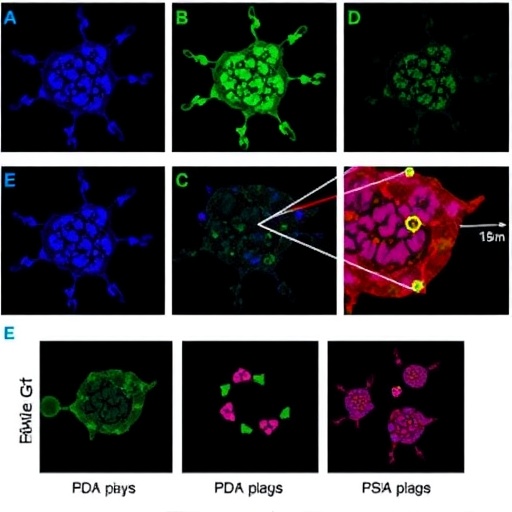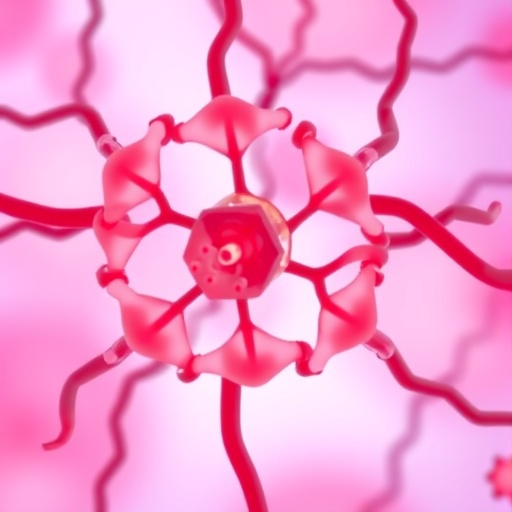In a significant leap forward for cellular biology, researchers at Rice University have pioneered a revolutionary technique that enables living cells to autonomously produce and utilize a 21st amino acid. This innovation allows proteins to emit light in real time as they undergo subtle modifications inside living cells. The advancement transcends traditional investigative methods by providing an unprecedented, non-invasive glimpse into the dynamics of post-translational modifications (PTMs), which are fundamental molecular switches controlling growth, aging, and disease pathways. The results from this groundbreaking research are slated for publication in the prestigious journal Nature Communications.
Understanding the intricacies of protein behavior within living organisms has long been a formidable challenge due to the transient and delicate nature of PTMs. Typically, studying these modifications required invasive approaches such as cell lysis or the introduction of synthetic chemical probes. However, the Rice team’s breakthrough circumvents these limitations by genetically engineering cells to produce acetyllysine, a fluorescently active lysine derivative, effectively introducing an element within the cellular machinery that can literally “light up” to mark biological events as they unfold. This development provides a continuous, live readout of molecular changes without perturbing native cell function.
At the heart of this technique lies the strategic manipulation of enzymatic systems capable of synthesizing acetyllysine intracellularly. Leveraging synthetic biology, the researchers introduced genes encoding specific enzymes into bacteria and human cells. These enzymes catalyze the formation of acetyllysine inside the cellular environment, which is then seamlessly incorporated into proteins at designated sites. Upon the addition or removal of PTMs, these modified proteins exhibit luminescence, effectively emitting fluorescent signals that researchers can detect in real time. This elegant design replaces the need for external chemical labels traditionally fed to cells to visualize protein modifications.
The research team’s motivation was grounded in addressing the limitations of conventional labeling methods, which rely heavily on administering large, often toxic quantities of synthetic compounds to cells. By endowing cells with the intrinsic capability to generate their own glowing amino acids, the new system provides a self-sufficient and less perturbative way to observe molecular phenomena. The real-time visibility into the “invisible choreography” of intra-cellular proteins offers a transformative lens through which biological processes can be studied in their natural, living context.
One compelling demonstration of the sensor’s utility focused on the enzyme SIRT1, a histone deacetylase known to modulate inflammatory responses and implicated in cancer biology. By employing the synthetic amino acid sensor to monitor acetylation events controlled by SIRT1, the team observed that inhibition of this enzyme’s activity did not uniformly suppress tumor growth across all cell lines tested, challenging some existing theories in cancer research. This nuanced insight underscores how the technology can illuminate complex regulatory mechanisms previously masked by less precise methodologies.
This study’s implications stretch far beyond oncology. The ability to track PTMs dynamically in living cells opens new avenues for investigating aging processes, neurological disorders, and complex diseases characterized by spatiotemporal protein regulation. Since the luminescent readouts are compatible with live tissues, they enable researchers to monitor disease progression or treatment efficacy in real time. Such capabilities position this technology as a potent tool for drug screening, especially in the search for compounds targeting enzymes that regulate protein modifications.
Looking forward, the researchers envision extending this approach to a wider spectrum of post-translational modifications beyond acetylation. Modifying this platform to incorporate other unnatural amino acids that mark processes like phosphorylation or methylation could vastly expand our ability to dissect cellular signaling pathways. Moreover, integrating these sensors within sophisticated human-derived organoid systems promises to bridge the gap between molecular research and personalized medicine, offering tailored insights into patient-specific disease mechanisms.
The innovative approach surmounts a longstanding bottleneck in epigenetic research by providing a living cellular sensor that converts molecular events into detectable light emissions. This conversion transforms elusive biochemical signals into visible biological narratives, illuminating the dynamic regulation of proteins that underpin health and disease. With real-time monitoring capabilities embedded at the molecular level, researchers gain unparalleled access to the foundational processes that govern cellular life.
This research was spearheaded by Han Xiao, professor of chemistry, bioengineering, and biosciences at Rice University and a Cancer Prevention and Research Institute of Texas Scholar. Xiao emphasized the groundbreaking aspect of equipping living cells to autonomously produce and sense unnatural amino acids, opening direct windows into the biochemistry of living animals. The first author, Yu Hu, a postdoctoral researcher, highlighted the revolutionary potential of this technology to reshape our understanding and therapeutic strategies for diseases tied to protein regulation.
The project’s success reflects a collaborative effort involving multiple Rice University scientists, including Yixian Wang, Linqi Cheng, Chenhang Wang, Yijie Liu, Yufei Wang, and others, supported by prominent funders such as the SynthX Seed Award, the National Institutes of Health, the Robert A. Welch Foundation, and the U.S. Department of Defense. Together, this team has established a versatile, powerful platform for probing the living cell’s inner workings with unprecedented clarity and precision.
Through this engineering marvel, cells no longer remain inscrutable black boxes but become transparent theaters where the molecular ballet of life is illuminated. As researchers continue refining and expanding this technology, it holds promise to revolutionize biomedical research and lead to new diagnostics and therapies that harness the language of protein modifications—a language now visible in living color.
Subject of Research: Engineering living cells to autonomously produce and utilize a 21st amino acid as a fluorescent sensor to monitor post-translational modifications in real time.
Article Title: Engineering unnatural cells with a 21st amino acid as a living epigenetic sensor
News Publication Date: 23-Oct-2025
Web References:
https://www.nature.com/articles/s41467-025-64448-1
DOI: 10.1038/s41467-025-64448-1
Image Credits: Photo by Jeff Fitlow/Rice University
Keywords: Amino acids, Protein activity, Bacteria, Tumor cells, Tumor development, Amino acid sequences
Tags: acetyllysine as a fluorescent markeradvancements in protein behavior analysisfluorescent amino acids in protein studiesgenetic engineering in cellular researchglowing sensors for cellular monitoringinnovations in cellular dynamics observationmolecular switches in growth and diseaseNature Communications publicationnon-invasive cellular biology techniquespost-translational modifications in living cellsreal-time observation of cellular changesRice University protein research





